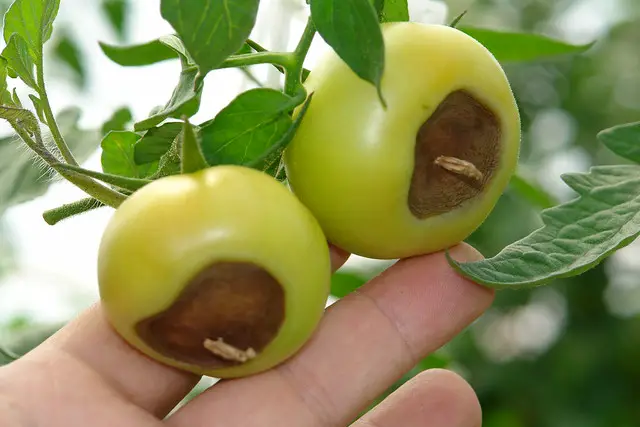Every farmer wants a healthy crop at the time of harvest, but, what if you grew tomatoes and during harvest you find black or brown bottomed tomatoes infected with blossom end rot? In this article, we’ll provide a complete guide about blossom end rot and the methods to prevent and fix the disease.

What Is Blossom End Rot?
The disease is caused by an imbalance of water and lack of calcium due to rapid growth from a high quantity of fertilizer and salts. This can also be caused by a water drought.
Blossom end rot is common in tomatoes, peppers, melons, squash, cucumbers, eggplant and cabbage.
How To Identify If you have Blossom End Rot – Symptoms and Causes
The disease can occur in both green and ripened fruits; where there will appear a water-soaked area. As the fruit grows, the water-soaked area widenes and turns into a black/brown leathery spot. Later, secondary pathogens attacks the fruit and results in black/brown, fuzzy-like mold growth at the affected area.
The reasons plants do not get sufficient calcium are:
- Overwatering or Drought: Excessive application of water may be due to rainfall or manual over-watering or drought. Poor drainage of soil can also cause a lack of calcium. To avoid this problem, you can directly apply calcium to your crops.
- Calcium Deficiency: Calcium is necessary for even growth of plants where lack of water makes it difficult for the plant to up-take the calcium from the soil. Therefore, black spots appear at the bottom of fruits due to deficiency of calcium in the plants.
- Too Much Nitrogen: Too much nitrogen application causes less availability of calcium to the plant.
- Cold Soil Temperature: Cold soil interferes with nutrient uptake of plants.
- Root Damage: Damage of root system due to aggressive digging can also cause interruption nutrient uptake which eventually leads to blossom end rot.
- High pH: High level of soil pH decreases the number of available nutrients in the soil which can be another reason for blossom rot end.
- Disease Prone Variety: Certain varieties of crops are more prone to diseases such as blossom end rot.
Prevention and Control of Blossom End Rot
Blossom end rot cannot be cured and you cannot heal the rotten tomatoes. However, you can try the following preventative measures:
- Apply Calcium(kelp and calcium solution) is recommended to keep the soil evenly moist which has an adequate amount of available nutrients for plants. To prepare the foliar application of calcium, mix 1-2 tablespoons of 5% liquid calcium in a gallon of water. For excellent results, you can also add a natural surfactant in the solution for better adhesion and solution run-off. You can add a high level of calcium such as oyster shells, gypsum and bone meal to prevent the deficiency of calcium in the soil.
- Manual removal of blossom end rot: if the black spot is small, you can trim off the part of the tomato and use the rest of the fruit or vegetable. You can try to manage or stop the rot to a certain extent by controlling the poor supply of water and fertilizers
- Planting crops timely: Planting tomatoes in the right time of the season will help manage the supply of an adequate quantity of balanced fertilizers and organic matter. It means tomatoes will have enough time for growth without the application of extra fertilizers. Make sure the fertilizers you are using should be lower in nitrogen and higher in phosphorus and, applied in only recommended rates.
- Avoid root damage: Be careful while digging around the plant to avoid root damage, it can interrupt the uptake of calcium from the soil.
- Water appropriately:Maintain an adequate supply of water in your garden. The soil should be moistened to 6 inches once or twice a week to ease the uptake of calcium for the plants.
- Plant healthy varieties: choose and plant healthy and resistant varieties of vegetables in your garden. The rotten tomatoes can be picked from the plants and discarded when the season progresses.
- Mulch application: You can add mulches (grass, straw, compost) to cover the soil near the base of the plants. This will help to retain the moisture of the soil in the dry weather during July and August.
- Soil pH: Maintaining a soil pH near or at 6.5 pH will interrupt in the supply of calcium and other mineral nutrients to the plants. You can use a soil test kit to identify your soil pH.
- Avoid planting in cold soil: In cold temperature, avoid planting and the soil become warm before planting. Cold soil limits the uptake of minerals and nutrients to the plants.